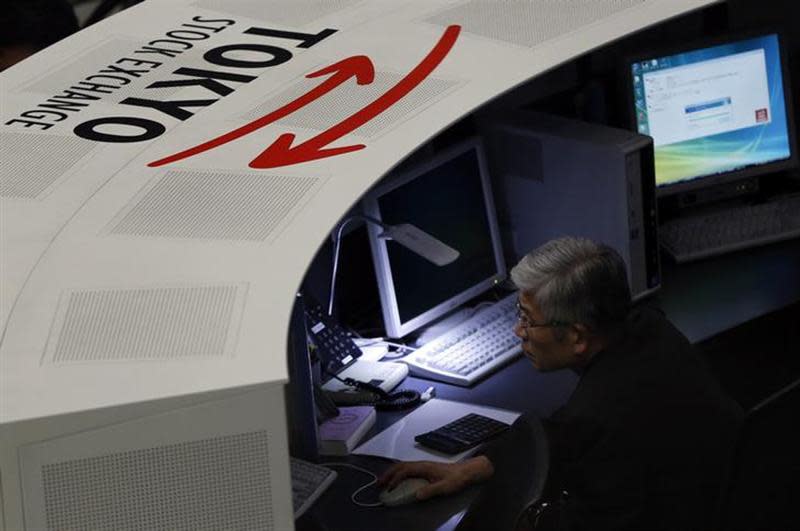World stocks rise, yen dips as Crimea tension eases
By Angela Moon
NEW YORK (Reuters) - World stocks rose sharply on Monday as prices of the safe-haven yen and U.S. Treasuries fell, a day after Crimea's vote to join Russia passed without major violence, easing fears that had driven world stocks to a one-month on Friday.
The yen fell broadly after the United States and the European Union imposed what investors perceived to be only modest economic sanctions on some officials of Russia and Ukraine following Crimea's vote to join Moscow.
Although investors are not ruling out another flare-up in tensions between Russia and Ukraine, many do not expect contagion to major markets. The lack of military conflict between the two countries also appeased investors.
"The sanctions don't sound particularly aggressive," said Richard Franulovich, senior currency strategist at Westpac Securities in New York. "Also, some of the worst-case scenarios they were anticipating over the weekend, such as actual military engagement, did not really materialize."
Wall Street opened sharply higher on Monday, up more than 1 percent, rebounding from last week's steep decline.
"This is a classic example of too much fear and anxiety having been in the market. Last week's decline more than discounted any bad news that could be reasonably expected to come out," said Donald Selkin, chief market strategist at National Securities in New York.
The Dow Jones industrial average rose 187.19 points, or 1.17 percent, to 16,252.86. The S&P 500 gained 18.45 points, or 1 percent, to 1,859.58, and the Nasdaq Composite added 45.208 points, or 1.06 percent, to 4,290.605.
The geopolitical tension over Ukraine weighed on equities last week, with the S&P 500 suffering its biggest weekly loss in seven and the CBOE Volatility index jumping to its highest level since early February on Friday.
The MSCI world equity index, which tracks shares in 45 countries, rose 0.7 percent, after hitting a one-month low on Friday.
The dollar rose 0.4 percent against the yen, to 101.76 yen, after four days of losses.
The euro gained 0.6 percent against the yen, to 141.83 yen. It also climbed against the dollar, to $1.3941, despite a dip in euro zone inflation, the latest indicator to argue for outright money-printing by the European Central Bank to support growth.
Europe's common currency has traded within a cent of a 2-1/2-year high around $1.3967 since Thursday, when the ECB president, Mario Draghi, voiced concerns about the euro's strength.
European stocks rose 1.1 percent, and the broader Euro STOXX 600 rose around 1.2 percent. Emerging stocks (.MSCIEF) added 0.6 percent.
Shares from the mining and industrial sectors featured among the biggest gainers, with BHP Billiton (BLT.L) up 1.2 percent and ArcelorMittal (ISPA.AS) up 1.12 percent
FED IN FOCUS
In the latest economic data, the New York Fed's Empire State gauge of New York manufacturing rose in March, helped by increases in new orders and inventories, though the rise was less than forecast. Separately, U.S. industrial output rose 0.6 percent in February, a far bigger rise than had been expected.
"The data gives us another kick up, since it is another sign that we're recovering from recent weather issues," said Selkin, who helps oversee about $3 billion in assets.
With the Crimea vote out of the way, investors are now focusing on the Fed's two-day policy meeting that begins on Tuesday; the central bank is expected to continue to reduce the size of its bond purchase program but alter its forward guidance.
"They are going to move away from thresholds on specific economic indicators and take a more holistic approach that depends on subjective evaluation of a broad array of economic indicators. They are trying to move back to a more normal approach to policy," said Ward McCarthy, chief financial economist at Jefferies in New York.
The Fed previously said that it would not raise interest rates until joblessness fell to at least 6.5 percent, a pledge that policymakers thought would hold until at least mid-2015. But that rate hit a five-year low of 6.6 percent in January, before rising to 6.7 percent in February.
Benchmark 10-year notes fell 8/32 in price on Monday to yield 2.67 percent, in the middle of a two-month long range that has kept yields between 2.57 percent and 2.82 percent.
U.S. crude oil rose further on Monday, gaining for a third session in a row. U.S. crude oil fell 0.4 percent to $98.52 a barrel.
(Additional reporting by Gertrude Chavez-Dreyfuss; Editing by Chizu Nomiyama and Leslie Adler)


